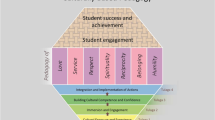Abstract
The kaupapa on raising engagement and achievement of Pasifika students motivates Pasifika leaders, families and Pasifika communities to work alongside school leaders, teachers and educators. Pasifika leaders are driven by their aspirations for all Pasifika students to be successful in education and life-long learning. This article explores the voices of nine Pasifika leaders living within New Zealand and what they perceive are critical issues for advancing outcomes in a culturally responsive practices and understandings. The research uses a Pasifika methodology, known as Talanoa that affords a culturally suitable situation for the researcher and research participants to talk in a spontaneous manner about whatever arises. The research investigation found seven key concepts: Strengthening culturally responsive leadership; Pasifika ‘heart’; Deep knowledge of Pasifika cultural world views; Provision of quality teaching and learning; Strengthening community engagement and partnership; Setting high expectations for success and achievement; Advocating for the Pasifika Education Plan.


Similar content being viewed by others
References
Allen, P., Taleni, T., & Robertson, J. (2009). In order to teach you I must know you. Pasifika Initiative: A professional development project for teachers. New Zealand Journal of Educational Studies, 44(2), 47–62.
Amituanai-Toloa, M., McNaughton, S., Lai, M., & Airini, (2010). Ua aoina le manogi o le lolo: Pasifika schooling improvement research: Full technical report. Wellington, NZ: Ministry of Education.
Bishop, R. (2011). How effective leaders reduce educational disparities. In J. Robertson & H. Timperley (Eds.), Leadership and learning (pp. 27–40). Los Angeles, CA: Sage.
Bishop, R., & Berryman, M. (2010). Te Kotahitanga: Culturally responsive professional development for teachers. Teacher Development, 14(2), 173–187.
Bishop, R., & Berryman, M. (2012). Te Kotahitanga: Investigating the sustainability of the Te Kotahitanga professional development project. Auckland: The National Institute for Research Excellence in Māori Development and Advancement, University of Auckland.
Bryk, A. S., & Schneider, B. (2003). Trust in schools. A core resource for school reform. Educational Leadership, 60(6), 40–45.
Chamberlain, M. (2014). PIRLS 2010/11 in New Zealand: An overview of national findings from the third cycles of the Progress in International Reading Literacy Study (PIRLS). Retrieved from http://www.educationcounts.govt.nz.
Clay, M. (1985). Reading: The patterning of complex behaviour. Auckland, NZ: Heinemann.
Education Review Office. (2012). Improving education outcomes for Pacific learners. Wellington, NZ: Ministry of Education.
Fergusson, D. M., Lloyd, M., & Norwood, L. J. (1991). Teacher evaluations of the performance of boys and girls. New Zealand Journal of Educational Studies, 2, 155–163.
Fullan, M. G. (1993). Why teachers must become change agents? Educational Leadership, 50(6), 1–13.
Fusitu’a, L., & Coxon, E. (1998). Ko e ‘Ulungaanga Faka-Tonga mo e Ako Lelei: Tongan culture and academic achievement. New Zealand Journal of Educational Studies, 33(1), 23–38.
Hancock, K. (2003). Men of Mana. Wellington, NZ: Steele Roberts.
Harker, W. J. (1978). Reading and study skills: An overview for teachers. Literacy, 12(2), 2–9.
Harris, F. (2009). Can Māori children really be positioned as “deficient” learners for reading English? English Teaching: Practice and Critique, 8(3), 123–145.
Holmes, L. D., & Holmes, E. R. (1992). Samoan village then and now (2nd ed.). Fort Worth, TX: Harcourt Brace Jovanovich.
Huffer, E., & Alfred, S. (2000). Pule’aga: Views of governance in Samoa. In E. Huffer & A. Soo (Eds.), Governance in Samoa: Pulega i Samoa (pp. 41–66). Canberra, Qld: University of the South Pacific.
Lagatule, T. (2015). Minutes from Mau Kit Te Ako Pasifika Advisory Group Meeting, October 2015.
Macfarlane, A. H., Webber, M., Cookson-Cox, C., & McRae, H. (2014). Ka Awatea: An iwi case study of Māori students’ success. Report prepared for Ngā Pae o te Māramatanga. Christchurch, NZ: University of Canterbury.
Meleisea, M. (1987). The making of modern Samoa. Traditional authority and colonial administration in the modern history of Western Samoa. Suva, Fiji: University of the South Pacific.
Ministry of Education. (1995). Form 7 physical education: A handbook for Teachers. Wellington, NZ: Learning Media.
Ministry of Education. (2011). Progress against Pasifika Education Plan 2009–2012. Wellington, NZ: Ministry of Education.
Ministry of Education. (2013). Pasifika Education Plan 2013–2017. Wellington, NZ: Ministry of Education.
Ministry of Education. (2014). Pasifika education plan—policy to practice. Wellington: Retrieved from http://nzcurriculum.tki.org.nz/Curriculum-resources/NZC-Online-blog/Pasifika-Education-Plan.
Ministry of Education. (2015). Ministry of Education four-year plan 2015–2019. Better Education for New Zealand. Wellington, NZ: Ministry of Education.
Nash, R. (2000). Educational inequality: The special case of Pacific students. Social Policy Journal of New Zealand, 15, 69–86.
OECD. (2014). PISA 2012 Results: What students know and can do—student performance in mathematics, reading and science (Vol. 1, Revised edition, February 2014), PISA, OECD Publishing. https://doi.org/10.1787/9789264201118-en.
Smith, G. H. (1999a). Paulo Freire: Lessons in transformative praxis. In P. Roberts (Ed.), Paulo Freire, politics and pedagogy. Reflections from Aotearoa-New Zealand. Palmerston North, NZ: Dunmore Press.
Smith, L. (1999b). Decolonizing methodologies. Research and indigenous peoples. Dunedin: University of Otago Press.
Statistics New Zealand. (2013). 2013 Census QuickStats about national highlights. Retrieved from http://www.stats.govt.nz/Census/2013-census/profile-and-summary-reports/quickstats-about-national-highlights.aspx.
Tamasese, K., Masoe-Clifford, P., & Ne’emia-Garwood, S. (1988). Pacific peoples’ perspective. In Royal Commission (Ed.), Royal Commission on Social Policy: Future directions (Vol. 4, pp. 573–592). Wellington, NZ: Royal Commission on Social Policy.
Tangaere, A. R. (2006). Collaboration and te kōhanga reo. Childrenz Issues: Journal of the Children’s Issues Centre, 10(2), 35–37.
Tillman, L. (2002). Culturally-sensitive research approaches: An African-American perspective. Educational Researcher, 3(9), 3–12.
Vaioleti, T. M. (2003). Talanoa research methodology: A perspective on Pasifika Research. Paper presented to the Power, Politics and Practice Pasifika Conference, Auckland, April 2003.
White, G. M., & Lindstrom, L. (1997). Chiefs today. Traditional Pacific leadership and the postcolonial state. Los Angeles, CA: Stanford University Press.
Author information
Authors and Affiliations
Corresponding author
Rights and permissions
About this article
Cite this article
Taleni, T.O., Macfarlane, S., Macfarlane, A.H. et al. Tofa liuliu ma le tofa saili a ta’ita’i Pasefika: Listening to the Voices of Pasifika Community Leaders. NZ J Educ Stud 53, 177–192 (2018). https://doi.org/10.1007/s40841-018-0114-7
Received:
Accepted:
Published:
Issue Date:
DOI: https://doi.org/10.1007/s40841-018-0114-7




